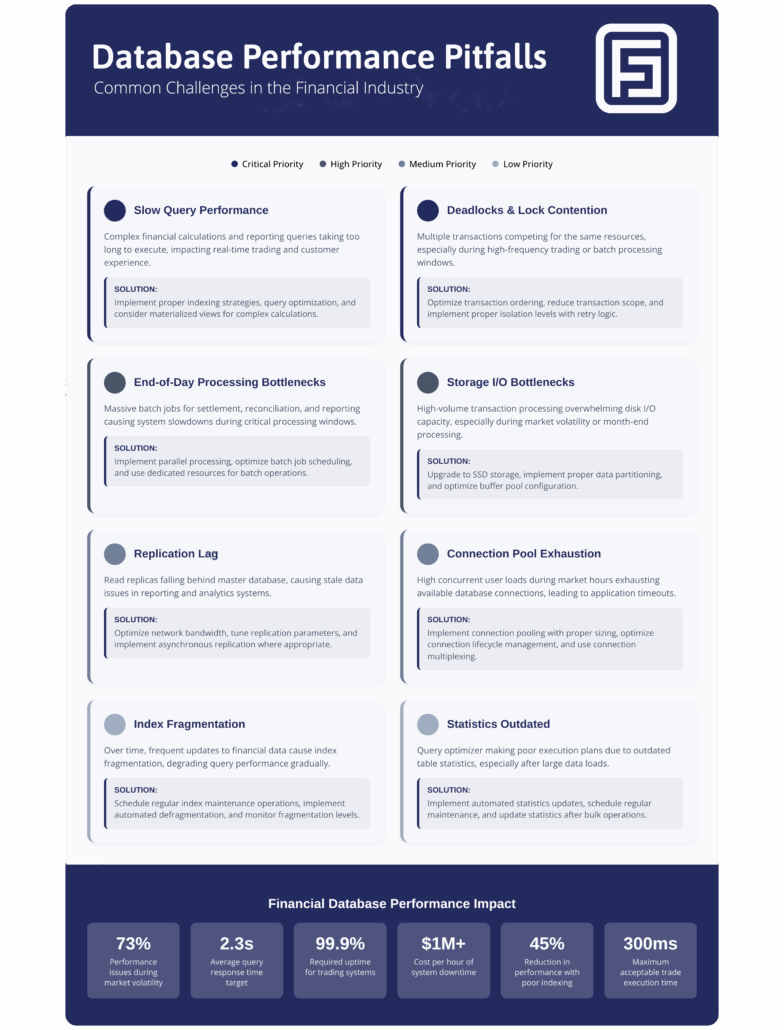Financial Services: How Poor Database Performance Costs You Customers
In the financial services industry, milliseconds matter. A trading system that responds 100 milliseconds slower than competitors can mean the difference between profit and loss. A customer portal that takes five seconds to load account information drives users to seek alternatives. Yet many financial institutions continue to operate with financial database performance issues that directly impact their bottom line and customer retention. Addressing these challenges through banking database optimization is crucial for success.
The Real Cost of Database Delays
When customers interact with your digital banking platform, execute trades, or access their portfolio information, they expect instant responses. Behind every click lies a complex database query that must execute flawlessly under pressure. Poor financial database performance creates a cascade of problems that extend far beyond IT metrics.
Consider a typical customer scenario: logging into a mobile banking app to check account balances before making a purchase. If database queries take three seconds instead of 300 milliseconds, that customer experiences frustration. Multiply this across thousands of daily interactions, and you’re looking at systematic customer dissatisfaction that competitors are eager to capitalize on.
Research consistently shows that financial services customers have among the highest expectations for digital performance. A 2024 study found that 67% of banking customers would switch providers after experiencing slow application performance more than twice. In an industry where customer acquisition costs average $1,500 per new account, losing existing customers due to technical performance becomes an expensive proposition. This highlights the urgent need for banking database optimization.

Where Database Performance Impacts Financial Operations
Trading Systems: Speed as Competitive Advantage
High-frequency trading environments represent the extreme end of financial database performance requirements. Trading algorithms may execute thousands of transactions per second, each requiring real-time access to market data, risk calculations, and position information. Database latency measured in microseconds can determine whether a trade executes profitably.
However, performance requirements extend beyond algorithmic trading. Retail trading platforms serving individual investors also depend on responsive databases. When a customer places a market order, the system must instantly verify account balances, check position limits, update portfolios, and confirm execution. Database bottlenecks at any point can result in delayed executions, leading to customer complaints and potential regulatory issues. This underscores the importance of continuous banking database optimization.
Customer-Facing Applications: Digital Experience Excellence
Modern banking customers interact with financial institutions primarily through digital channels. Mobile apps, web portals, and online banking platforms all rely heavily on financial database performance to deliver seamless experiences. Common scenarios where database performance directly affects customer satisfaction include:
- Account Balance Inquiries: Customers expect immediate access to current balances and transaction history. Database queries that aggregate transaction data, calculate available balances, and retrieve recent activity must execute quickly across millions of accounts simultaneously.
- Loan Application Processing: Digital lending platforms require real-time credit checks, income verification, and risk assessment calculations. Slow database responses during application processes increase abandonment rates and reduce conversion.
- Investment Portfolio Management: Customers accessing investment accounts need real-time portfolio valuations, performance calculations, and market data integration. Database performance issues create delays that undermine confidence in the platform’s reliability.
Compliance and Reporting: Regulatory Requirements
Financial institutions operate under strict regulatory oversight requiring comprehensive reporting and audit trails. These compliance requirements generate substantial database workloads that can impact overall system performance if not properly managed. This is another area where banking database optimization is critical.
Regulatory reporting often involves complex queries across multiple years of transactional data. Risk calculations may require analyzing millions of transactions to identify patterns or calculate exposure metrics. When these compliance processes compete for database resources with customer-facing applications, performance degradation affects both regulatory deadlines and customer experience.
Technical Performance Indicators That Drive Business Results
Understanding financial database performance requires monitoring metrics that correlate with business outcomes. Key indicators include:
- Query Response Time: The elapsed time between query submission and result return. For customer-facing applications, response times over 200 milliseconds become noticeable to users. Trading systems may require sub-millisecond response times for critical operations.
- Concurrent Connection Handling: Financial applications often experience peak usage during market hours or specific times of day. Database systems must maintain performance levels while handling thousands of simultaneous connections without degradation.
- Transaction Throughput: The number of database transactions processed per second directly correlates with business capacity. Higher throughput enables more customers to access services simultaneously without performance impact.
- Resource Utilization: CPU, memory, and storage utilization patterns reveal potential bottlenecks before they impact customer experience. Proactive monitoring prevents performance issues during critical business periods.
Common Database Performance Challenges in Financial Services
- Legacy System Integration: Many financial institutions operate hybrid environments combining modern applications with legacy systems developed decades ago. These legacy databases often lack optimization for current transaction volumes and user expectations. Integration layers that translate between old and new systems can introduce additional latency that compounds financial database performance issues.
- Data Volume Growth: Financial services generate enormous amounts of data through transactions, market feeds, customer interactions, and regulatory requirements. Traditional database architectures that performed adequately with smaller data sets often struggle as information volumes grow exponentially. This necessitates ongoing banking database optimization.
- Peak Load Management: Financial markets create predictable usage patterns with concentrated activity during trading hours, month-end processing, and quarterly reporting periods. Database systems must scale dynamically to handle these peak loads without impacting performance during normal operations.
- Security and Compliance Overhead: Financial databases require extensive security controls, encryption, and audit logging that can impact performance. Balancing regulatory compliance requirements with optimal performance requires careful architecture planning and ongoing optimization.
Strategies for Improving Financial Database Performance
Implementing effective banking database optimization strategies is key to overcoming these challenges:
- Intelligent Query Optimization: Modern database management systems provide sophisticated query optimization capabilities, but financial applications often require custom optimization strategies. Analyzing query patterns specific to financial operations helps identify opportunities for performance improvements through indexing strategies, query restructuring, and data partitioning.
- Strategic Data Architecture: Separating operational databases from analytical workloads prevents reporting queries from impacting customer-facing application performance. Data warehousing strategies that maintain real-time synchronization while distributing query loads across multiple systems optimize both performance and reliability.
- Proactive Monitoring and Alerting: Implementing comprehensive performance monitoring that correlates database metrics with business outcomes enables proactive issue resolution. Automated alerting systems that trigger before customer experience degrades help maintain service levels during peak usage periods.
- Scalability Planning: Financial institutions must plan database capacity for both steady-state growth and peak load scenarios. Cloud-native database solutions offer dynamic scaling capabilities that automatically adjust resources based on demand, ensuring consistent performance while controlling costs.
The Business Case for Database Performance Investment
Improving financial database performance requires investment in technology, processes, and expertise. However, the business benefits typically provide compelling returns on investment:
- Customer Retention: Faster application performance directly correlates with higher customer satisfaction scores and reduced churn rates. Retaining existing customers costs significantly less than acquiring new ones.
- Operational Efficiency: Optimized databases enable staff to process more transactions, handle customer inquiries faster, and complete regulatory reporting within required timeframes.
- Competitive Advantage: Superior digital experience quality differentiates financial institutions in crowded markets where product offerings are increasingly commoditized.
- Risk Reduction: Reliable database performance reduces operational risk, helps ensure regulatory compliance, and minimizes exposure to service disruptions that can damage reputation.
Moving Forward: Banking Database Optimization as Strategic Priority
Financial institutions that treat financial database performance as a strategic priority rather than a technical afterthought position themselves for success in an increasingly digital marketplace. The investment required for banking database optimization pays dividends through improved customer experience, operational efficiency, and competitive positioning.
Working with experienced database performance specialists helps financial institutions identify optimization opportunities specific to their business requirements and regulatory environment. The goal is creating database infrastructure that not only meets current performance demands but scales to support future growth and innovation.
In financial services, your database performance directly impacts your customer relationships. Every millisecond of delay is a potential customer walking away. The question isn’t whether you can afford to optimize your database performance—it’s whether you can afford not to.



Leave a Reply
Want to join the discussion?Feel free to contribute!